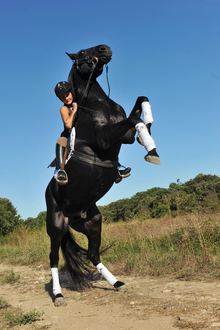Location: LEXINGTON, Kentucky
Youâve seen those commercials talking about replacing your mattress after every eight yearsâafter all, thatâs a lot of dead skin cells, dirt, dust mites, etc., that gathers every night.

Properly protecting your head when riding your horse
Go ahead, take a moment from reading this to find your horse-riding helmet and look at the tags inside. Most likely it is time to replace that helmet for safety's sake.
And when it comes to your favorite pair of riding pants, you donât think twice about replacing them when theyâre starting to be worn thin, or maybe showing a little too much wear and tear. But do you even think about how old your helmet is?
Go ahead, take a moment from reading this to find your helmet and look at the tags inside. Weâll waitâ¦
Did you see the date? Or is it so faded you canât tell if thatâs a three or an eight? Can you even remember when you purchased it? It might just be time to buy a new helmet.
As we prepare to celebrate the seventh annual Riders4Helmets International Helmet Awareness Day on Saturday September 17th, we want to applaud everyone who doesnât think twice about putting on a helmet before swinging their leg over a horse. They are the ones that know that wearing a helmet can help reduce the chance of a lethal head injury.
But if youâve worn helmets most of your life, you might be the type to just pick up the same old helmet that has gotten you through your junior rider years and onto your adult classes becauseâ¦well, itâs âbroken inâ and more comfortable. But wearing a helmet thatâs passed its limit of effectiveness might not fully protect you in the way an updated helmet can.
Did you know that helmet manufacturers generally recommend that you replace your helmet every four to five years? Think about all the time you spend in the saddleâthe liters of sweat, the coats of dust, and drenching from the rains all take a toll on your helmet and causes the Styrofoam inside to break down, reducing its effectiveness at protection.
If youâve had an accident while wearing your helmet, no matter how minor it was (i.e., your head just barely hit the ground), that can reduce the effectiveness of the helmetâs protection. Damage to the helmet might not be visible to the naked eye, so you canât assume there is no issue after a fall. Of course, any catastrophic incident can render a helmet useless and cause for an immediate replacement.
And when you do go to purchase a new helmet, take precautions when it comes to proper fit and ensuring the date of manufacture. When trying on helmets, be sure to wear your hair the way you would any time you rideâif you prefer a bun, wear a bun, if you prefer a ponytail, wear your hair in a ponytailâthen go shop.
Also, check the manufacture date on the inside of the helmet, no matter if youâre purchasing new or used. Take caution when considering purchasing a used helmet, since the helmet may have sustained damage from a previous incident that you canât see.
Donât think that only children or novice riders should be the ones to wear an approved helmetâthere has been no statistical correlation between skill level and the likelihood of an injury when it comes to equestrian sport. You can even have a catastrophic injury from falling off a horse thatâs standing still.
If you like to think with your head, take a moment to consider your head first and wearing proper protection.
To find out more about International Helmet Awareness Day, visit Riders4Helmets and learn how leading helmet manufacturers around the globe are offering special discounts to help keep you safe in the saddle this year.
Article provided by Riders4Helmets
